Charting Fluxus: George Maciunas’s Ambitious Art History
March 6–May 6, 2013
MoMA, The Lewis B. and Dorothy Cullman Education and Research Building

Fluxus was an international network of artists active in the 1960s and 1970s. Through the tireless efforts of its founder George Maciunas, Fluxus presented festivals and concerts and distributed artists’ multiples, which Maciunas fabricated in his Soho loft. Collective, performative, anti-institutional, and irreverent, Fluxus sought to bridge the gaps between different artistic mediums and between art and life.
In 1973 Maciunas announced his intention to design a grand art history chart, an exhaustive chronicle of Fluxus that would also narrate the movement’s origins since the beginning of performance-based art. Later that year, he produced the breathtakingly detailed Diagram of Historical Development of Fluxus and Other 4 Dimentional, Aural, Optic, Olfactory, Epithelial and Tactile Art Forms, which he called, simply, “the chart.”
Maciunas’s chart—which he never considered complete—reveals not only the history of Fluxus but also an ambitious reckoning with modernism and its legacy. This exhibition of objects in the Museum’s Gilbert and Lila Silverman Fluxus Collection Archives presents the “final” 1973 version of Maciunas’s chart alongside archival documentation that illustrates its genesis and its significance in the very history of art it maps.
The exhibition is organized by Julia Pelta Feldman, Project Archivist, Museum Archives.
All items in this exhibition are from The Gilbert and Lila Silverman Fluxus Collection Archives in The Museum of Modern Art Archives. Numbers in brackets identify the documents’ specific folder locations.
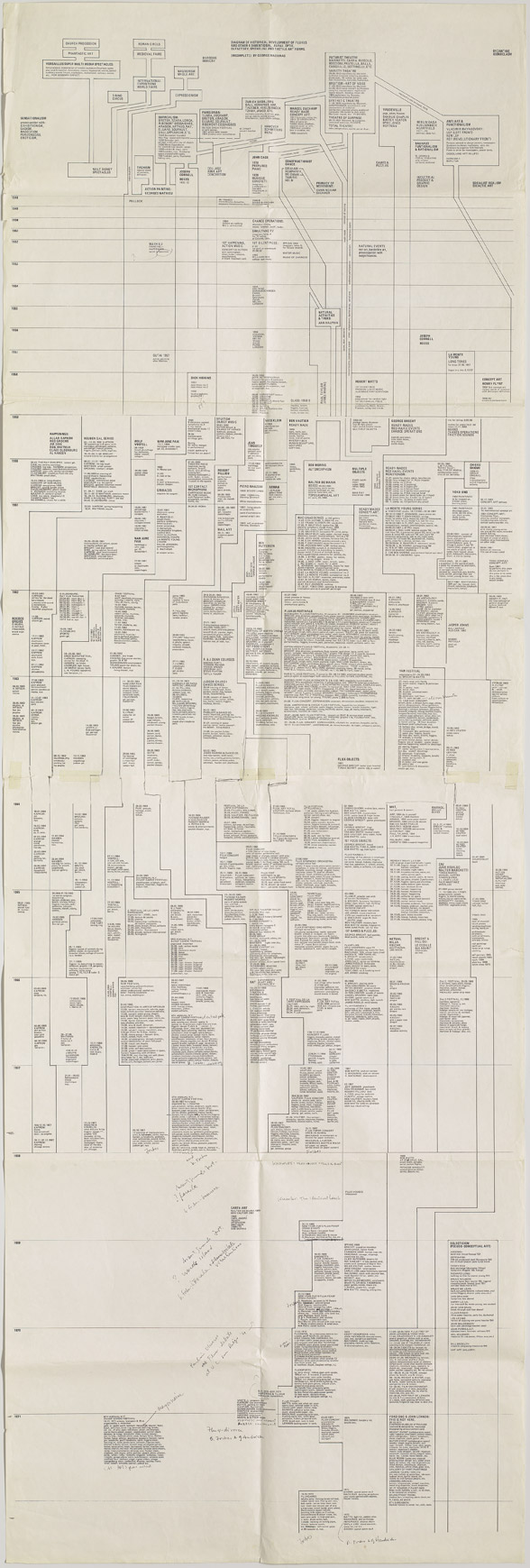
George Maciunas, Diagram of Historical Development of Fluxus and Other 4 Dimentional, Aural, Optic, Olfactory, Epithelial and Tactile Art Forms, annotated by Alison Knowles. 1973 [V.B.1.201*]
Maciunas’s ambitiously detailed art history chart positions Fluxus, often relegated to an art historical footnote, as the culmination of a distinguished artistic lineage. The chart elucidates connections between various artistic phenomena that are often considered only in isolation. Maciunas’s project thus calls to mind the famous art history chart designed by MoMA’s first director, Alfred H. Barr, Jr., for his seminal 1936 exhibition Cubism and Abstract Art, which traced the development of the early-twentieth-century avant-garde. Maciunas was trained as a graphic designer, and he brought his talent for design brilliantly to bear in visualizing this wealth of information. He kept this copy of the chart, with suggested edits by Fluxus artist Alison Knowles, folded up among his files.
Fluxus Newsletters and Ephemera
The scope of George Maciunas’s ambitions for Fluxus is evident in the many newsletters and mailings he designed and disseminated to Fluxus artists and to potential customers for their work. A consummate organizer of concerts, projects, and events, Maciunas could also be somewhat tyrannical: he sought to impose his grand collective vision for Fluxus on his friends and fellow artists. As demonstrated by the chart, Fluxus came to encompass a multitude of artworks (called “fluxkits”) and performance pieces, but many projects never came to fruition. The perpetually unfinished chart at the center of this room is only one example of the many projects by Maciunas that were too ambitious or utopian to be fully realized. All items in this case are by Maciunas.
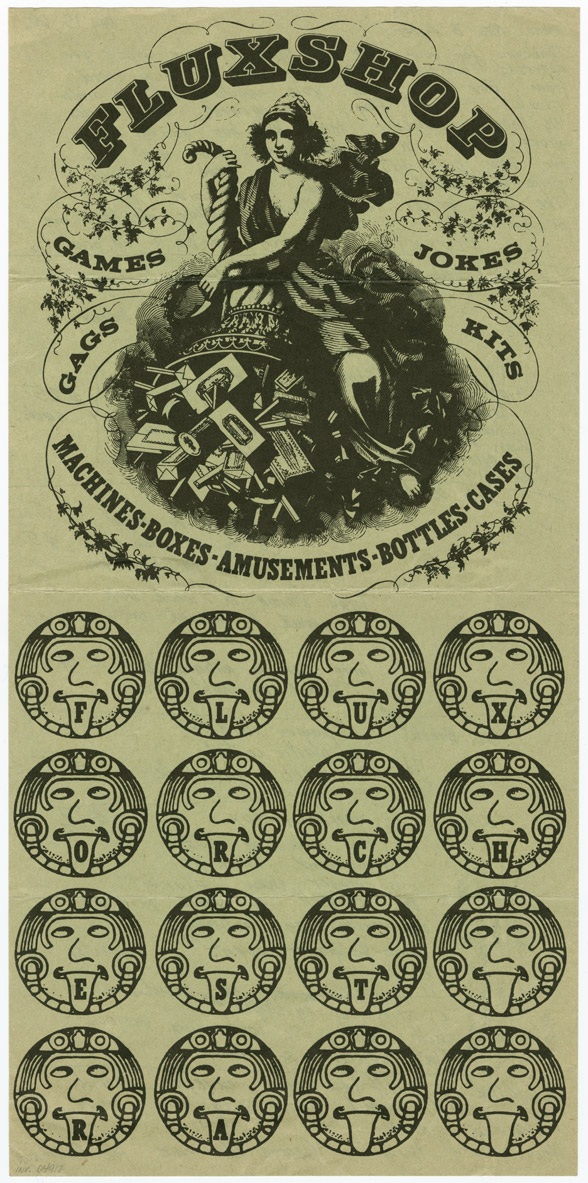
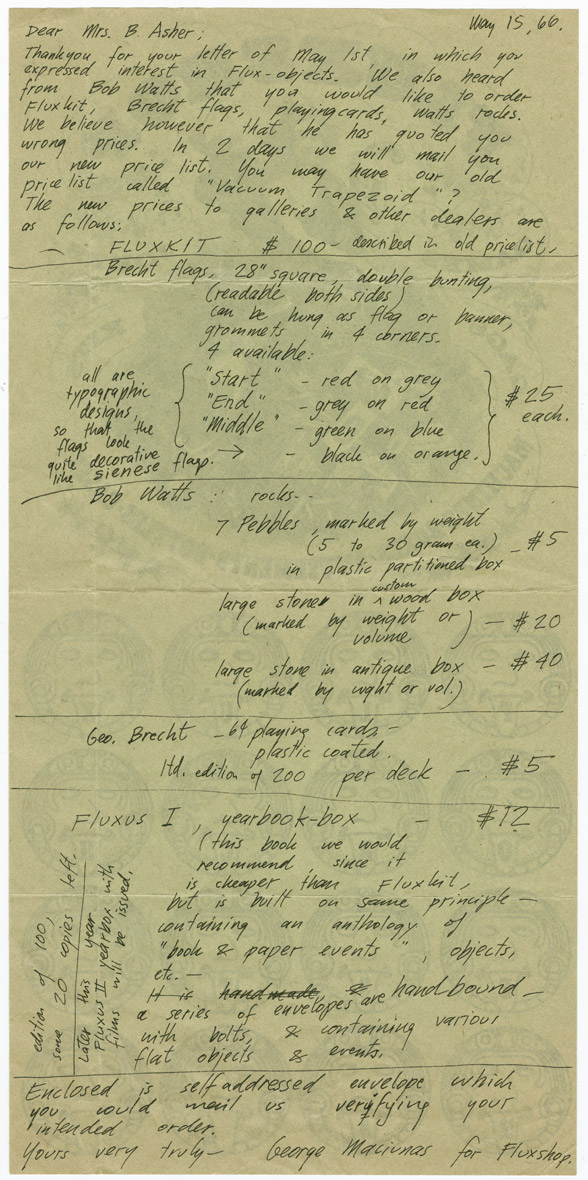
Fluxshop stationery, with letter from George Maciunas to Betty Asher about purchasing Fluxus works on verso. 1966 [V.A.1.1]
The “fluxshop,” from which Fluxus editions could be purchased, was a concept rather than a physical space. Maciunas handled the distribution of works himself.
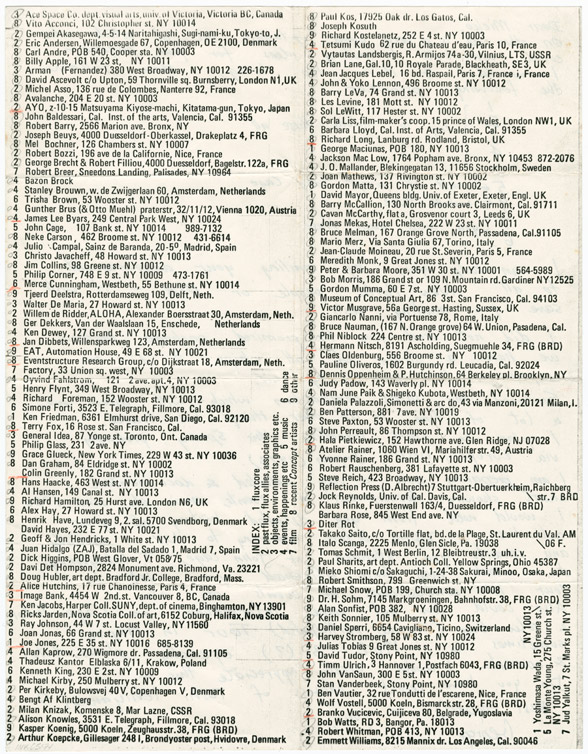
Fluxus distribution list. n.d. [V.A.1.35]
Here, Maciunas categorized members of his network by a numbered “index.” The numbers next to each name correspond to a key at the center of the document. Its reverse is a letter from Maciunas to Fluxus artist Mieko Shiomi (see below).
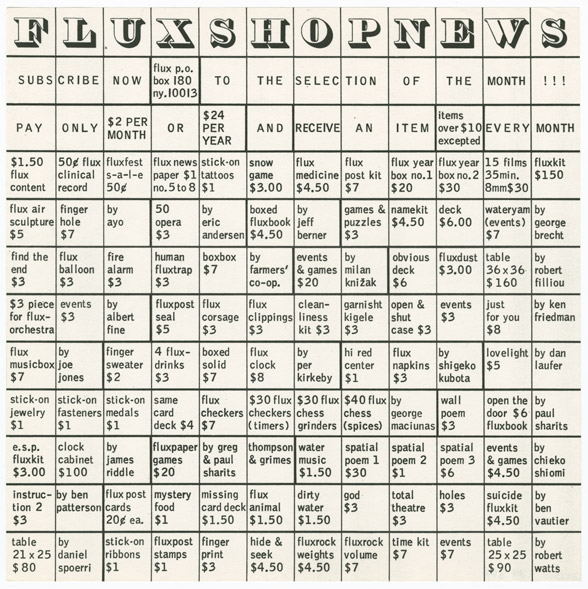
Fluxshop News pricelist. n.d. [V.F.1]
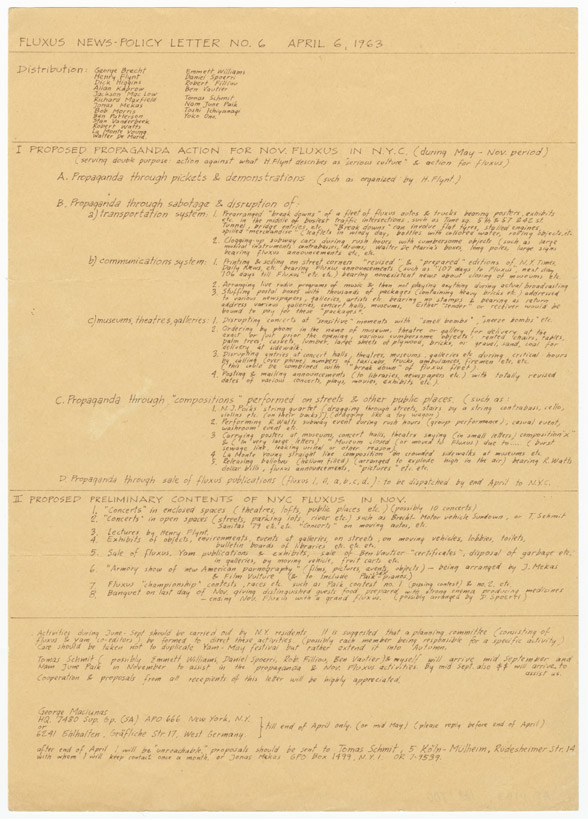
“Fluxus News Policy Letter No. 6.” 1963 [V.F.9] Scroll compilation of news articles about Fluxus. n.d. [V.F.3] “Conditions for Performing Fluxus Published Compositions . . . ” and addendum. c. 1965 [V.F.9]
This document’s controlling tone provoked outrage among Fluxus artists when Maciunas circulated it. This necessitated the addendum below it, in which Maciunas defends his insistence on collectivity.
“Tentative Plan for Contents of the First 7 Issues” (letter to Jonas and Adolfas Mekas) 1962 [V.A.1.23]
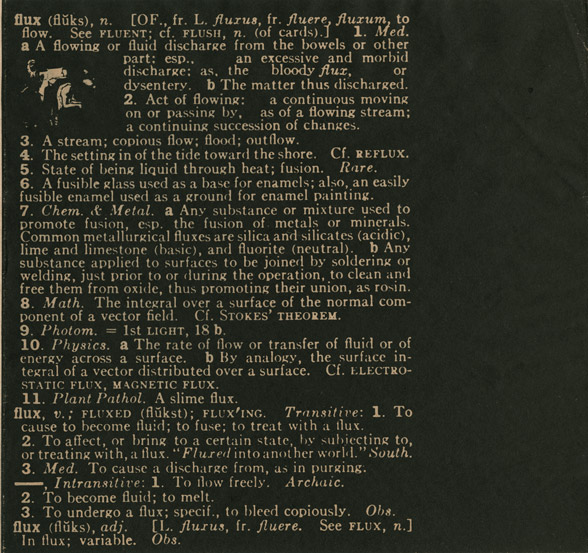
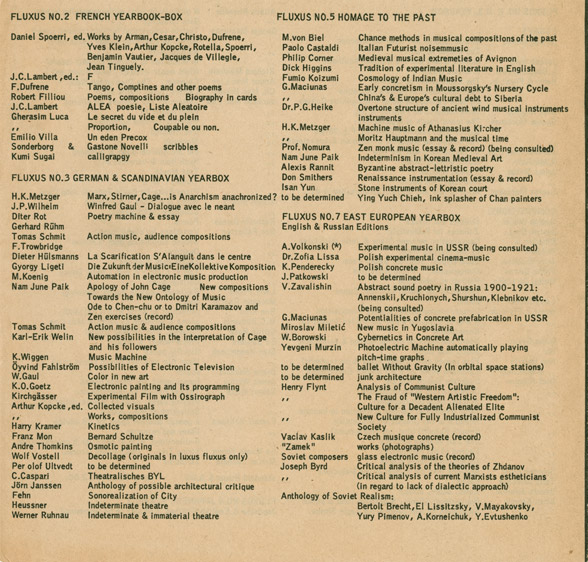
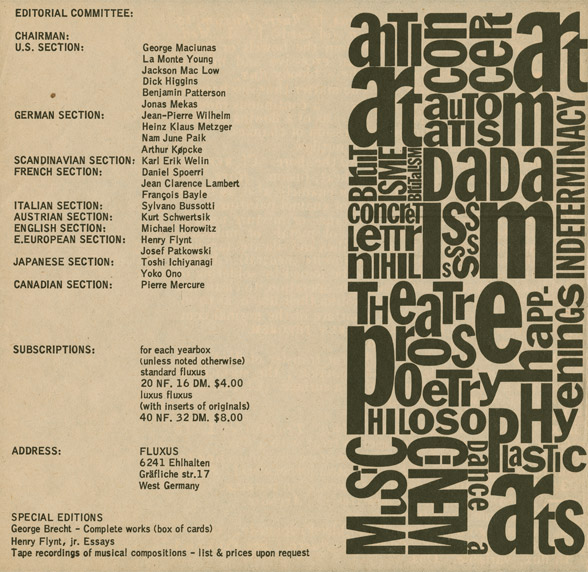
Brochure prospectus for Fluxus Yearboxes, second version. 1962 [V.F.8]
These plans for the annual “Yearboxes” Maciunas envisioned in 1962 demonstrate his prodigious intentions for Fluxus. Maciunas’s idea of nationally grouped or thematic yearboxes never came to pass. Only two of the listed projects, Fluxus 1 and 2, were realized, and they differed significantly from this initial concept.
Researching Fluxus
Even before he announced work on his grand art history chart, George Maciunas was soliciting his friends for their complete artistic histories and gathering ephemera from Fluxus events to use as source material. All items in this case are by Maciunas, unless otherwise specified.
Fluxnewsletter. 1973 [V.F.14]
At bottom of this detailed missive is Maciunas’s official announcement of his plan to create the chart.
Letter from Maciunas to the Pratt Institute Library, with response. 1971 [V.B.1.115] Letter from Maciunas to Ken Friedman. n.d. [V.A.1.10]
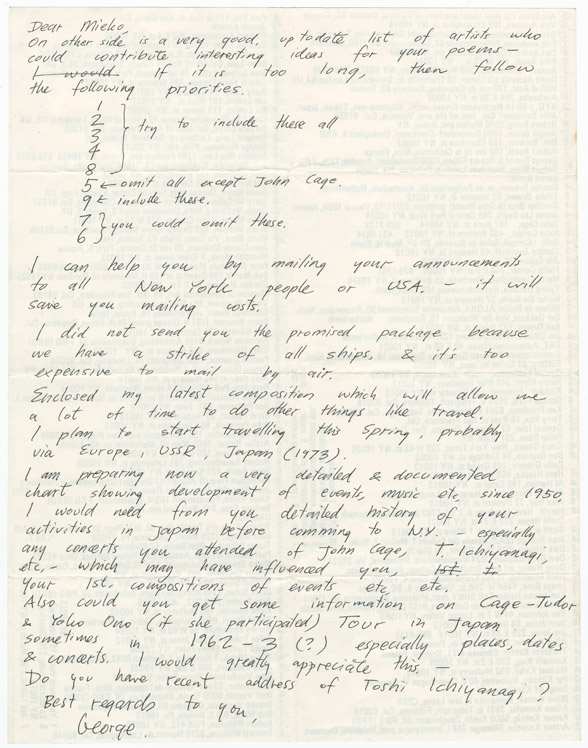
Letter from Maciunas to Mieko Shiomi. n.d. [V.A.1.35]
The back of this letter – a list of artists coded by type, which Maciunas suggests Shiomi use as a mailing list – appears above as “Fluxus distribution list.” The mention of the chart is near the bottom.
Flyer for Flux Game Fest. 1973 [IV.A.15] Flyer for Flux Vehicle Day. 1973 [IV.A.15] Announcement for events organized by Maciunas at his AG Gallery. 1961 [IV.A.3]
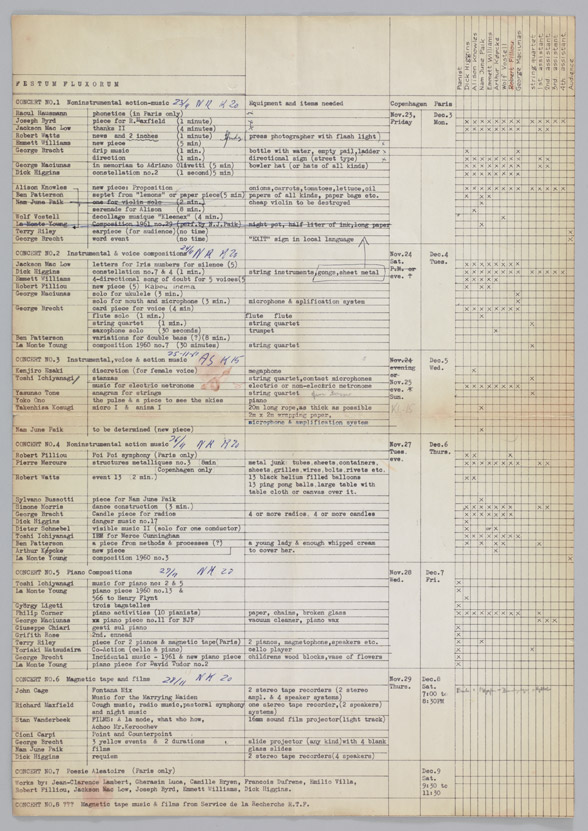
Performance plan for Festum Fluxorum annotated by artist Arthur Køpcke. 1962 [IV.B.55*] News clippings about Festum Fluxorum in Copenhagen. 1962 [IV.B.52]
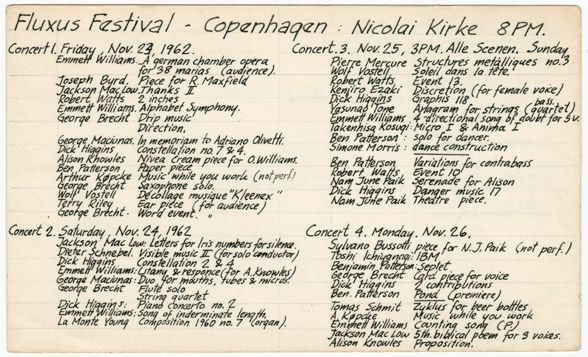
Index card notes on Fluxus concerts, with notes for Festum Fluxorum at top n.d. [V.D.1.8]
The Festum Fluxorum concerts, which took place in Copenhagen, were among the earliest Fluxus performances. The plan for the festival differed from the actual event, the details of which Maciunas recorded in the topmost index card on the stack. In the image at the top of the news clippings, Maciunas is performing his work In Memoriam to Adrianno Olivetti, which used discarded adding machine paper as a performance score.
Charting Fluxus
This case presents George Maciunas’s notes and working material for his art history chart. Much of this material comes from Maciunas’s own files for the chart, in which he gathered ephemera and copious notes in addition to the biographical information he requested from his network of artists. All items in this case are by Maciunas, unless otherwise specified.
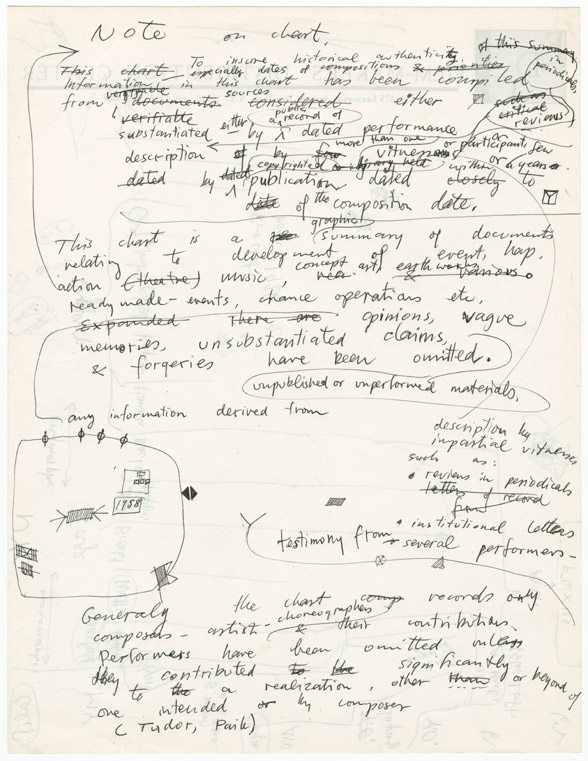
Draft of “note on chart”. n.d. [V.B.115]
The final version of this explanatory note was attached to the copies of the chart that Maciunas distributed.
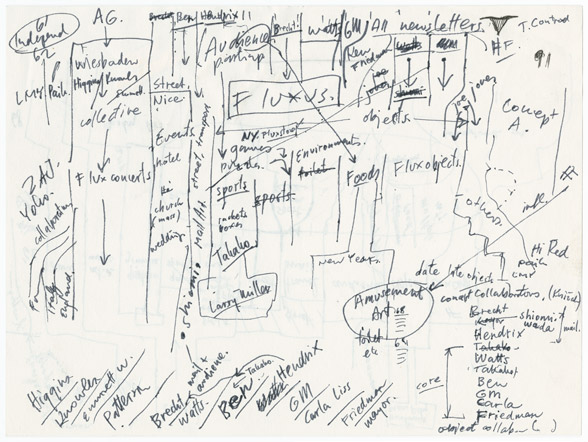
Rough sketch for chart. n.d. [V.B.115] Autobiographical notes by Geoffrey Hendricks. n.d. [V.B.118] Maciunas’s file on John Cage (notes by unknown author, with annotations by Maciunas) c. 1973 [V.B.1.99]
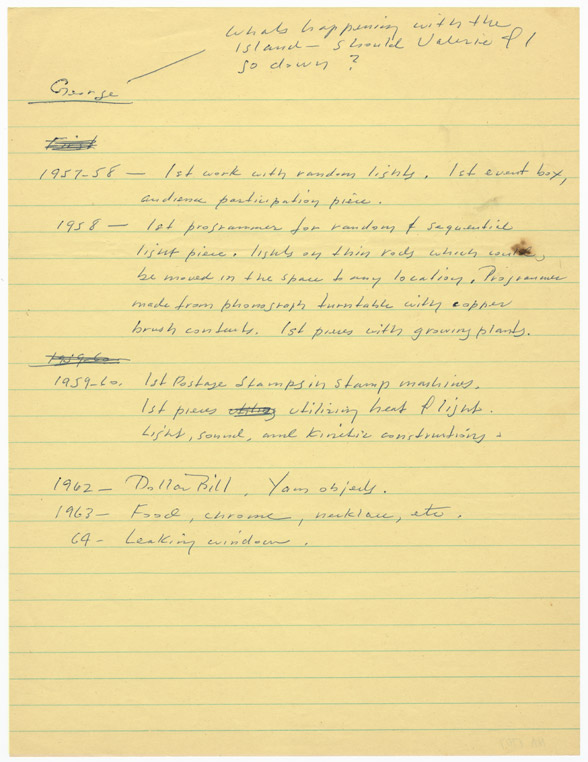
Autobiographical notes by Robert Watts. n.d. [V.B.118] Autobiographical notes by Henry Flynt. n.d. [V.B.115] October—November calendar. 1973 [V.E.8]
Maciunas made calendars that he used as detailed journals. Here, he recorded his daily work on the chart as well as its completion and distribution to Fluxus artists such as Dick Higgins, Jonas Mekas, and George Brecht.
Envelope of text cut from the chart. 1973 [V.B.115] Envelope of text cut from the chart. 1973 [V.B.117]
The “final” version of the chart did not contain these texts, which list dance performances and concrete poetry.
George Maciunas as Art Historian
In the chart, George Maciunas’s wonderful graphic sensibility met his ambitious approach to art history. Maciunas had studied art history at New York’s Institute of Fine Arts in the late 1950s, where his interest in charting and mapping connections was already evident. His art history notes from that period presage the two 1966 diagrams at the far end of the case, which are in turn antecedents to the 1973 chart. All items in this case are by Maciunas.
Notes on Scythian art. n.d. [V.D.2.4] Box of art history note cards. n.d. [V.D.1.5] Canisters of microfilmed art history notes. n.d. [V.D.5.10]
Maciunas was such a copious note taker that he sometimes microfilmed his notes and discarded the originals to save space.
Folder of art history notes. n.d. [V.D.3.7]
The top sheet shows Maciunas beginning to draw art historical connections across space and time.
“Development of Western Abstract Chirography as a Product of Far Eastern Mentality,” essay 1959 [V.D.3.34]
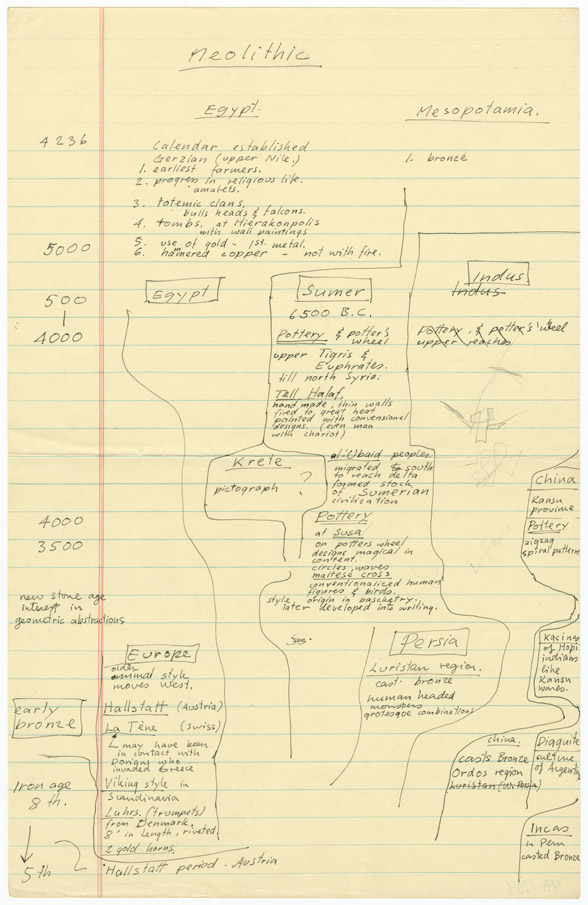
Sheet of art history notes (diagram). n.d. [V.D.3.25]
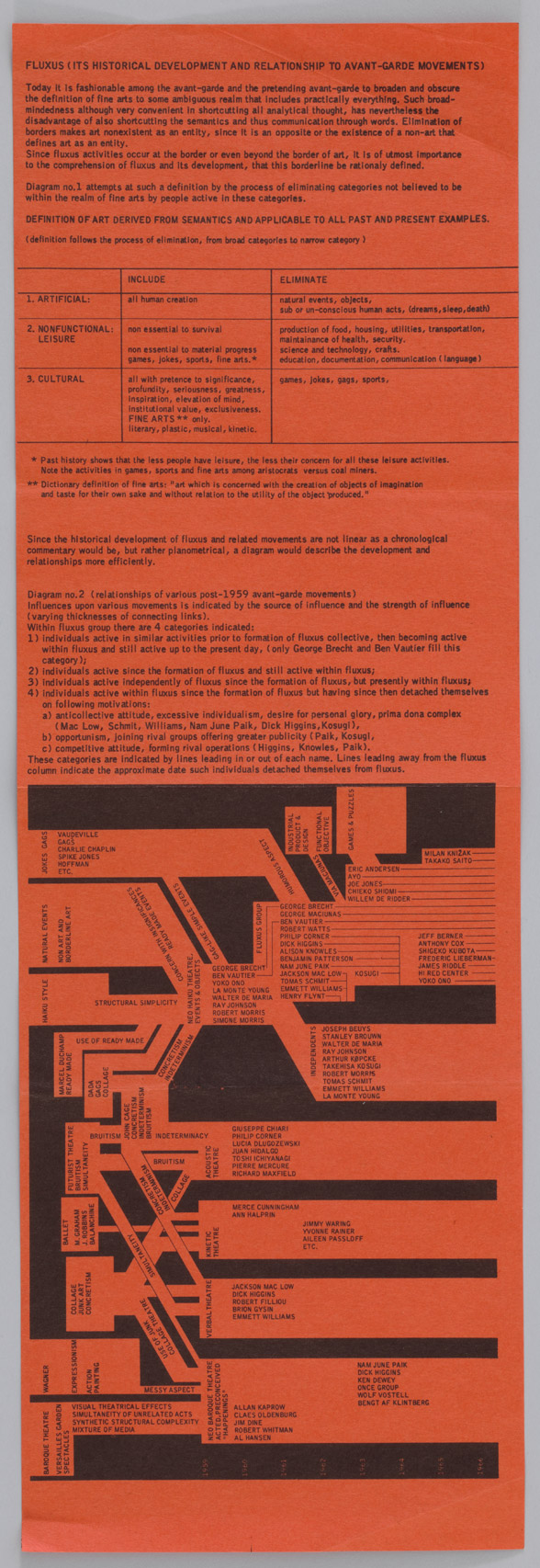
“Fluxus (its historical development and relationship to avant-garde movements)” 1966 [V.A.1.1]

“Expanded Arts Diagram,” from Film Culture—Expanded Arts, no. 43.1966 [V.B.16]
These two antecedents to the chart demonstrate Maciunas’s ongoing fascinating with mapping histories, which he also applied in his art historical studies.
Acknowledgements
I am indebted to the entire staff of the Museum Archives, but I especially wish to thank Michelle Elligott for her invaluable support, guidance, and patience. I am also particularly grateful to my comrades-in-arms, fellow processing archivists Christiana Dobrzynski-Grippe, Celia Hartmann, Jonathan Lill, and Alana Miller, who worked alongside me as I processed the Gilbert and Lila Silverman Fluxus Collection Archives and developed this exhibition. Without their sage advice, intelligent conference, and ready wit, I would never have made it this far. I am indebted to both the intellectual generosity and the encyclopedic knowledge of Jon Hendricks. Sara Dayton brought to life this website and the exhibition screens; Sara Bodinson, Rebecca Roberts, and Julianna Goodman, the text; and Tom Grischkowsky and Roberto Rivera, the images. Outside the Museum, I wish to thank Hannes Bajohr for his unflagging support and keen eye.